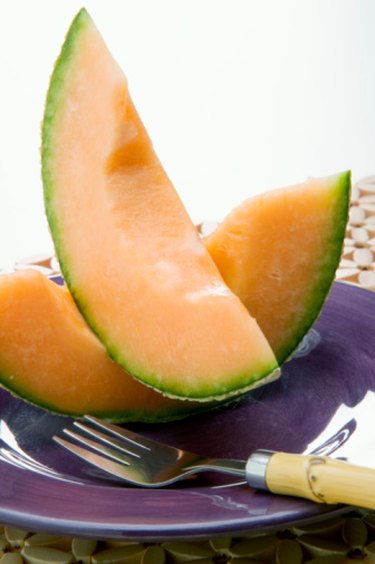
Americans interchange the names cantaloupes and muskmelons to describe the fragrant, sweet, orange melon fruits, but the cantaloupe is different from a muskmelon. All members of the species Cucumis melo, cantaloupes, muskmelons, honeydews and casabas are very closely related and the plants look physically similar until the fruits mature.
Cantaloupe vs. Muskmelon
Video of the Day
The only way to differentiate true cantaloupes from muskmelons is to compare the ripened melon fruit features. Cantaloupe fruits are round and have warty skin. Muskmelons are round and ribbed or grooved and display a netlike matrix on the skin. The vast majority of melons sold as cantaloupes in the United States are actually muskmelons, based on the fragrance and coarse netting pattern on the melon's exterior.
Video of the Day
Growth Habit
Cantaloupes grow as an annual vine that is sensitive to frost. It sprouts, grows, flowers, set fruit and dies within one growing season. Depending on the cultivar grown, the stems grow and mature at a length between 5 and 12 feet. The light green stems sprawl across the ground -- or clumsily climb up any vertical supports if available -- with prickly fuzz covering the stems and leaf stems. The leaves are held upright from the stems to catch as much sunlight as possible, raising 8 to 14 inches from the main vine stem.
Foliage
Cantaloupe plant leaves are medium to dark green in color, with lighter green undersides. The upper side is mildly glossy but coarse and sandpapery in texture. Each leaf generally looks like an abstract heart, but vary in having slightly wavy edges or shallow lobes. A cantaloupe leaf looks like a blend of a maple and grape leaf, but with dull rounder edges. Once a vine produces mature melon fruits, or drought or chilly weather occurs, the green leaves turn yellow and droop, eventually dying.
Flowering and Fruiting
Cantaloupe vines produce trumpet-shaped yellow male and female flowers separately on the plant. The first flowers to appear are male blossoms, which hold only pollen-shedding stamens. About a week later, both male and female flowers are produced on a plant. Only pollinated female flowers become melons. A female flower has a sticky clublike pistil and looking at the stem neck of the blossom reveals a swollen knob that houses the ovary. Bees pollinate the flower, the petal drops off and the ovary swells to create a round fruit with warty skin. Inside, the sweet, aromatic flesh surrounds a slimy core packed with lots of creamy beige seeds.